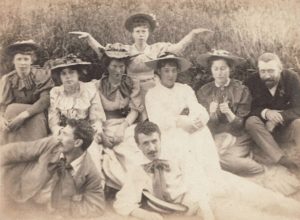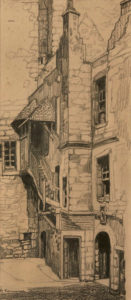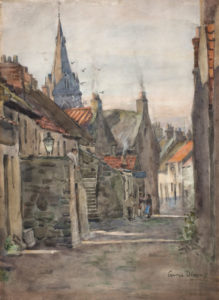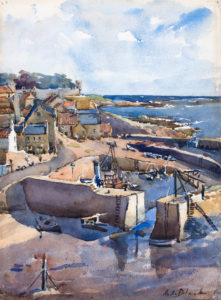

The Recording Scotland collection is a set of watercolours, oils and prints collected during World War II to permanently capture the landscapes and the “feeling” of the nation. Each piece of artwork was chosen because it captured an essential view of Scotland; with emphasis on the places most likely threatened by war and industrialization. This is part three of a series of blogs about different aspects of the Recording Scotland collection.
The Recording Scotland scheme provided an opportunity for male and female artists from across Scotland. Here we feature just a few of the female artists who contributed to the collection.
Katherine Cameron (1874-1965) came from a large, artistic family in Glasgow. Following her brother, D. Y. Cameron, she studied in Glasgow and later Paris, perfecting her techniques in etching, watercolour, and oils. She is most known for her work in capturing landscapes and flowers. She was a member of the Glasgow Society of Lady Artists, which provided a supportive network for meeting and exhibiting work. The group known as the “Glasgow Girls” were female artists trained in the 1890s and socialised with popular figures like Charles Rennie Mackintosh. The group of artists playfully called themselves “The Immortals,” referencing their love of Celtic mythology or possibly the immortality bestowed by creating artwork. Cameron married wealthy art collector, Arthur Kay in 1927. Two of her pieces purchased for the scheme were originally printed as illustrations in “Haunted Edinburgh” in 1928. Hundreds of her works are held by major institutions including the Victoria and Albert Museum in London and the Library of Congress in Washington, D.C.

Anna Dixon (1873-1959) was another prolific artist of birds, flowers, and figures in landscapes. Dixon enjoyed painting in France and the west coast of Scotland. Her artwork was known to feature crofts, donkeys, horses, and children. Of the pieces chosen for the Recording Scotland collection, her painting of Cross Wynd in Falkland highlights the domestic lives of the citizens.
May Marshall Brown (1887-1968), born May Mary Robertson, was the daughter of an Edinburgh wine merchant. She studied at Edinburgh College of Art and later married the artist, William Marshall Brown, who was 24 years her senior. His influence is witnessed in her style of work. May Marshall Brown is best known for her watercolours of fishing villages and boats. As she explained to the committee, “I mainly paint boats, sea and fishermen working, since the war I have not had a chance to continue the work, as one is so much disturbed by military at the shore, even when one has a permit to paint.” She was able to sell three paintings, and her late husband posthumously contributed four to the Committee. Brown was the artist who contributed last week’s piece, “Cat Row, Dunbar.” We will also learn more about one of William Marshall Brown’s paintings of the Oronsay Priory in a future post.
Ann Spence Black (1861-1947) provided seven paintings to Recording Scotland collection. Born in Dysart, Fife she was seemingly self-taught. She lived in Edinburgh and spent time painting the east coast of Scotland, and the areas around Culross. Black is one of the oldest contributors to the collection, being well into her 80s at the time of the Second World War.

The artwork contributed by women makes up about twenty percent of the collection which leaves the lion’s share to male artists and their representation of Scotland. It is also interesting to note that the female artists tended to be in the later decades of their lives. Many of the women were in their late 50s, 60s, and 70s when they were submitting works. Some of them, like May Marshall Brown, were also carrying on the legacies of others by sending works for consideration from departed family and friends.
The decades had been hard for these women artists who witnessed not only one war but two, but they persevered in their art and interests. For them and other women artists of this period in particular for Katherine Cameron and the rest of the Glasgow Girls It is not impossible to imagine they remembered fondly their “immortal” days before the turn of the century and hoped to secure a place in history by submitting these tender pieces to posterity.